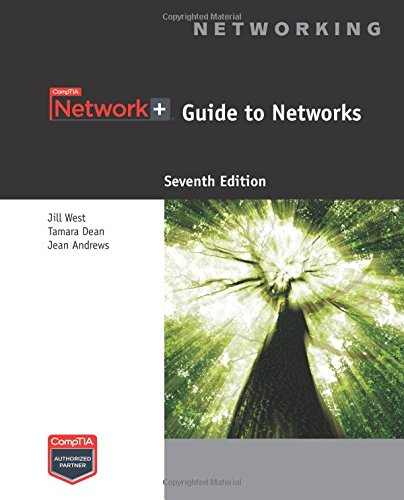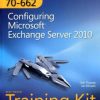Network Guide to Networks 7th Edition by Jill West, Tamara Dean, Jean Andrews 1305090942 9781305090941
$50.00 Original price was: $50.00.$35.00Current price is: $35.00.
Network Guide to Networks 7th Edition by Jill West, Tamara Dean, Jean Andrews – Ebook PDF Instant Download/Delivery: 1305090942, 9781305090941
Full download Network Guide to Networks 7th Edition after payment

Product details:
ISBN 10: 1305090942
ISBN 13: 9781305090941
Author: Jill West, Tamara Dean, Jean Andrews
Master the technical skills and industry know-how to begin an exciting career installing, configuring, and troubleshooting computer networks with the completely updated NETWORK GUIDE TO NETWORKS, 7E. You can prepare for success on CompTIA’s Network N10-006 certification exam with fully mapped coverage of all objectives, including protocols, topologies, hardware, network design, and troubleshooting. This edition addresses today’s latest technology with new features that make essential information easily accessible and help you visualize high-level concepts. New OSI layer icons visually link concepts and the OSI model. New and updated “On the Job” stories, Applying Concepts activities, Hands-On and Case Projects let you explore concepts in more depth. The NETWORK GUIDE TO NETWORKS, 7E’s emphasis on real-world problem solving provides the tools you need to succeed in any computing environment.
Network Guide to Networks 7th Table of contents:
Chapter 1. Introduction to Networking
How Networks Are Used
Client-Server Applications
File and Print Services
Communications Services
Controlling Network Access
Peer-to-Peer Network Model
Client-Server Network Model
Networking Hardware and Physical Topologies
LANs and Their Hardware
MANs and WANs
The Seven-Layer OSI Model
Layer 7: Application Layer
Layer 6: Presentation Layer
Layer 5: Session Layer
Layer 4: Transport Layer
Layer 3: Network Layer
Layer 2: Data Link Layer
Layer 1: Physical Layer
Protocol Data Unit or PDU
Summary of How the Layers Work Together
Staying Safe When Working with Networks and Computers
Emergency Procedures
HVAC Systems
Protecting against Static Electricity
Installation Safety
Electrical and Tool Safety in Data Centers
Troubleshooting Network Problems
Chapter Summary
Key Terms
Review Questions
Hands-On Projects
Case Projects
Chapter 2. How Computers Find Each Other on Networks
Overview of Addressing on Networks
MAC Addresses
How Host Names and Domain Names Work
DNS (Domain Name System)
How Ports and Sockets Work
How IP Addresses Are Formatted and Assigned
How IPv4 Addresses Are Formatted and Assigned
How IPv6 Addresses Are Formatted and Assigned
Tools for Troubleshooting IP Address Problems
Ping
ipconfig
ifconfig
nslookup
Chapter Summary
Key Terms
Review Questions
Hands-On Projects
Case Projects
Chapter 3. How Data Is Transported Over Networks
TCP/IP Core Protocols
TCP (Transmission Control Protocol)
UDP (User Datagram Protocol)
IP (Internet Protocol)
ICMP (Internet Control Message Protocol)
IGMP (Internet Group Management Protocol) on IPv4 Networks
ARP (Address Resolution Protocol) on IPv4 Networks
Routers and How They Work
Multilayer Switches
Routing Tables
Static or Dynamic Routing
The route Utility
Routing Metrics
Routing Protocols
Interior and Exterior Gateway Routing Protocols
Troubleshooting Router Issues
Troubleshooting Tools
Solving Common Routing Problems
Chapter Summary
Key Terms
Review Questions
Hands-On Projects
Case Projects
Chapter 4. Structured Cabling and Networking Elements
Network Equipment in Commercial Buildings
Components of Structured Cabling
Cable Management
Device Management
Rack Systems
NAS (Network Attached Storage)
SANs (Storage Area Networks)
Managing Power Sources and the Environment
Power Management
Monitoring the Environment and Security
NICs and Ethernet
Characteristics of NICs
Simplex, Half-Duplex, and Duplex
Ethernet Frames
Troubleshooting Network Devices
Building and Maintaining Network Documentation
Chapter Summary
Key Terms
Review Questions
Hands-On Projects
Case Projects
Chapter 5. Network Cabling
Transmission Basics
Analog Signaling
Digital Signaling
Data Modulation
Baseband and Broadband
Multiplexing
Throughput and Bandwidth
Twisted-Pair Cable
STP (Shielded Twisted Pair)
UTP (Unshielded Twisted Pair)
Comparing STP and UTP
Ethernet Standards for Twisted-Pair Cabling
Cable Pinouts
Copper Connectors and Couplers
PoE (Power over Ethernet)
Fiber-Optic Cable
SMF (Single Mode Fiber)
MMF (Multimode Fiber)
Fiber Connectors and Couplers
Fiber-Optic Converters and Modular Interfaces
Ethernet Standards for Fiber-Optic Cable
Troubleshooting Cable Problems
Transmission Flaws
Troubleshooting Tools
Chapter Summary
Key Terms
Review Questions
Hands-On Projects
Case Projects
Chapter 6. Wireless Networking
Characteristics of Wireless Transmissions
The Wireless Spectrum
Antennas
Signal Propagation
Signal Degradation
Frequency Ranges
Wireless PAN
Wi-Fi WLAN (Wireless LAN) Architecture
802.11 WLAN Standards
How Wi-Fi Works
Implementing a WLAN
Determining the Design
Configuring Wireless Connectivity Devices
Configuring Wireless Clients
802.11 Wireless Network Security
WPA/WPA2 (Wi-Fi Protected Access)
Security Threats to Wireless Networks
Troubleshooting Wireless LANs
Wireless Network Tools
Avoiding Pitfalls
Chapter Summary
Key Terms
Review Questions
Hands-On Projects
Case Projects
Chapter 7. Cloud Computing and Remote Access
Cloud Computing
Cloud Computing Categories
Deployment Models
Remote Access
Point-to-Point Remote Access Protocols
VPNs (Virtual Private Networks)
VPN Tunneling Protocols
Terminal Emulation or Remote Virtual Computing
Encryption Techniques, Protocols, and Utilities
Key Encryption
IPsec (Internet Protocol Security)
SSL (Secure Sockets Layer) and TLS (Transport Layer Security)
SSL VPN
SSH (Secure Shell)
SFTP (Secure File Transfer Protocol)
Hashes: MD5 and SHA
Authentication Protocols
RADIUS and TACACS+
CHAP and MS-CHAP
EAP (Extensible Authentication Protocol)
802.1X (EAPoL)
TKIP (Temporal Key Integrity Protocol) and AES (Advanced Encryption Standard)
Kerberos
SSO (Single Sign-On)
Troubleshooting Cloud Computing and Remote Access
Passwords
Misconfigurations
Chapter Summary
Key Terms
Review Questions
Hands-On Projects
Case Projects
Chapter 8. Network Risk Management
Security Assessment
Security Risks
Risks Associated with People
Risks Associated with Transmission and Hardware
Risks Associated with Protocols and Software
Risks Associated with Internet Access
Effective Security Policies
Security Policy Goals
Security Policy Content
Security in Network Design
NOS Security
Network Access Control
Access Control Lists Used by Routers
Intrusion Detection and Prevention
Firewalls
Proxy Servers
SIEM (Security Information and Event Management)
Scanning Tools
Honeypots and Honeynets
Troubleshooting Malware Risks and Infections
Malware Types and Characteristics
Anti-Malware Software
Anti-Malware Policies
Chapter Summary
Key Terms
Review Questions
Hands-On Projects
Case Projects
Chapter 9. Unified Communications and Network Performance Management
Fundamentals of Network Management
Baseline Measurements
Policies, Procedures, and Regulations
Monitoring and Managing Network Traffic
SNMP Logs
System and Event Logs
Traffic Analysis
Traffic Management
Caching
Unified Communications Technologies
VoIP Applications and Interfaces
Video over IP Applications and Interfaces
Signaling Protocols
Transport Protocols
QoS (Quality of Service) Assurance
DiffServ (Differentiated Service)
MPLS (Multiprotocol Label Switching)
CoS (Class of Service)
Troubleshooting Network Integrity and Availability
General Guidelines
Fault Tolerance
Data Backup
Chapter Summary
Key Terms
Review Questions
Hands-On Projects
Case Projects
Chapter 10. Network Segmentation and Virtualization
Segmentation and Subnetting
How a Computer Uses a Subnet Mask
CIDR (Classless Interdomain Routing)
Why Subnets?
Subnet Mask Tables
Supernetting
Subnetting in IPv6
Virtualization
Virtual Network Components
Virtual Machines and Network Adapters
Virtual Switches and Bridges
Network Connection Types
Virtual Appliances and Virtual Network Services
VLANs and Trunking
STP (Spanning Tree Protocol) and SPB (Shortest Path Bridging)
Switch Configurations
Wireless VLANs
Troubleshooting VMs and VLANs
Chapter Summary
Key Terms
Review Questions
Hands-On Projects
Case Projects
Chapter 11. Wide Area Networks
WAN Essentials
WAN Topologies
Bus Topology
Ring Topology
Star Topology
Mesh Topology
Tiered Topology
PSTN (Public Switched Telephone Network)
T-Carriers
Types of T-Carriers
T-Carrier Connectivity
Frame Relay
DSL (Digital Subscriber Line)
Types of DSL
DSL Connectivity
Broadband Cable
ATM (Asynchronous Transfer Mode)
SONET (Synchronous Optical Network)
MPLS (Multiprotocol Label Switching)
Metro Ethernet
Wireless WANs
802.16 (WiMAX)
Cellular
Satellite
Troubleshooting WAN Issues
Company Policies
Common ISP Problems
Chapter Summary
Key Terms
Review Questions
Hands-On Projects
Case Projects
Chapter 12. Industrial and Enterprise Networking
Industrial Networks
Components of an Industrial Control System and SCADA Network
Securing an ICS/SCADA Network
Asset Management and Business Documents
Asset Management
Business Documents
Change Management
Software and Hardware Changes
Change Management Documentation
Physical Security Controls
Troubleshooting and Response Policies
Disaster Recovery
Forensics
Chapter Summary
Key Terms
Review Questions
Hands-On Projects
Case Projects
Appendix A. CompTIA Network+ N10-006 Certification Exam Objectives
Appendix B. Numbering Systems
Appendix C. Visual Guide to Connectors
Appendix D. CompTIA Network+ Practice Exam
People also search for Network Guide to Networks 7th:
introduction to networks v7 companion guide
network+ guide to networks 8th edition answer key pdf
network+ guide to networks pdf free download
level 7 networking
Tags:
Jill West,Tamara Dean,Jean Andrews,Network



